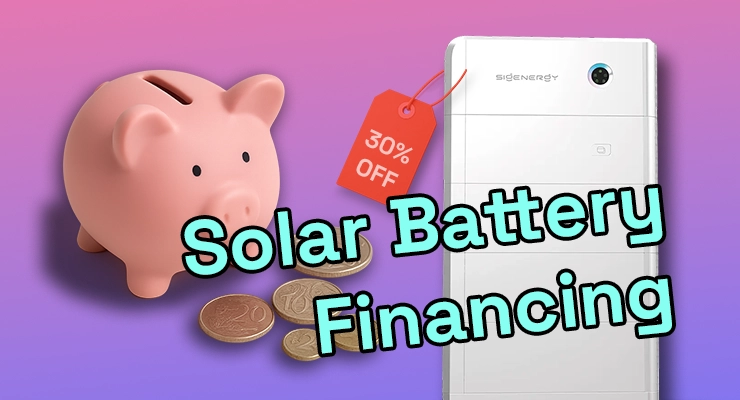Fast read
Financing a solar battery in Australia is more accessible than ever in 2025, thanks to a combination of government incentives and flexible private funding options. From 1 July 2025, a new federal battery rebate will reduce upfront costs by about 30%, which can be combined with state-specific support like interest-free loans in some areas. The main financing pathways include adding the cost to your home loan, taking out a dedicated low-interest green loan, or using a payment plan from your installer.
How can you finance a solar battery installation?
A home battery is a significant investment, but it’s one that promises greater energy independence and substantial savings on your power bills for years to come. While the upfront cost can seem daunting, a combination of new government incentives and a growing range of finance products means that installing a battery is now within reach for many Australian households.
Understanding your options is the first step to making a confident decision. This guide will walk you through the primary ways to finance a solar battery installation in Australia, helping you find the pathway that best suits your financial situation.
Before exploring private solar battery finance, it’s crucial to see what government support you’re eligible for. These incentives directly reduce the amount you need to borrow, making any financing arrangement more manageable.
The most significant new incentive is the Australian Government’s Cheaper Home Batteries Program, which starts on 1 July 2025. This program will provide a discount of around 30% on the upfront cost of an eligible battery installation for both homes and small businesses. This rebate is applied by your installer, so you get the discount immediately without complex paperwork.
Some state and territory governments also offer their own programs, which often combine with the federal rebate to boost your savings. These include:
Interest-Free Loans:
Some states provide loans that allow you to pay off the battery over several years without any interest charges. For instance, the ACT offers interest-free loans up to $15,000, repayable over 10 years, and Western Australia has a new scheme providing interest-free loans. It’s important to note that Victoria’s popular interest-free loan scheme has now closed to new applicants as of May 2025.
State Rebates:
Some states offer an additional point-of-sale rebate. Western Australia, for example, will offer rebates that can be combined with the federal program, potentially providing significant savings. Always check with your installer or on official government websites for the most current information, as these programs can change.
What are dedicated green loans?
One of the most popular ways to fund the remaining cost of a battery is through a green loan. These are specific personal loans offered by banks and other financial institutions for sustainable home upgrades.
Because they are designed for eco-friendly projects, green loans often feature more attractive terms than standard personal loans, such as lower interest rates and flexible repayment periods. Major banks and specialised lenders like Plenti, Brighte, and Australian Mutual Bank are active in this space. Competition in 2025 has led to competitive rates and features, like no fees for early repayment.
When considering a green loan, it’s wise to compare not just the interest rate but also any establishment or ongoing fees, as these contribute to the total cost of the loan.
Should I add the cost to my home loan?
For homeowners with a mortgage, using your home equity by adding the cost of the battery to your home loan is another common option. This can be done by “topping up” your existing loan or refinancing.
The primary advantage of this approach is the very low interest rate, which will typically be much lower than a personal or green loan. However, there’s a significant catch. Since most home loans stretch over 20–30 years, you may pay much more in total interest than if you used a shorter-term green loan.
If you take this path, financial experts advise you to stay disciplined and make extra repayments to pay off the battery portion within 5–10 years. Some banks also offer specific ‘green home loan’ products with competitive rates for these upgrades.
What about installer payment plans?
Many solar and battery installation companies offer their own financing solutions. Often called “buy now, pay later” (BNPL) or payment plans. These are often facilitated through third-party finance providers like Brighte or Plenti.
These plans can be very convenient, with fast approvals and sometimes no upfront deposit required. Some installers even offer interest-free periods, which can be very appealing. However, it is essential to read the terms and conditions carefully. After the interest-free period ends, the ongoing interest rate can be higher than other options.
This route is often best for those who want a simple, streamlined process managed directly by their installer and are confident they can pay off the balance within any promotional period.
Questions to ask your finance provider or installer
No matter which financing path you lean towards, asking the right questions is key to avoiding hidden costs and making an empowered choice.
- What is the exact interest rate, and is it fixed or variable?
- What is the comparison rate? This rate includes most fees and gives you a truer sense of the total cost.
- Are there any establishment fees, monthly account fees, or early repayment penalties?
- What is the total amount I will pay back over the life of the loan?
- Can I structure the loan repayments to match my expected electricity bill savings?
Making the right choice for your home
The best way to finance a solar battery depends entirely on your personal circumstances. Government rebates and loans should always be your first port of call to minimise the amount you need to borrow. From there, weigh the pros and cons of green loans, using your home loan, and installer payment plans against your financial goals.
By doing your research and seeking advice from accredited installers and financial professionals, you can fund your move to energy independence in a way that is both smart and sustainable.




